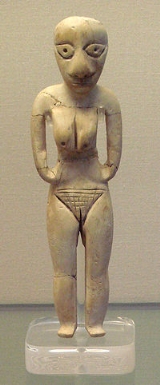
Badari
Encyclopedia

Upper Egypt
Upper Egypt is the strip of land, on both sides of the Nile valley, that extends from the cataract boundaries of modern-day Aswan north to the area between El-Ayait and Zawyet Dahshur . The northern section of Upper Egypt, between El-Ayait and Sohag is sometimes known as Middle Egypt...
during the Predynastic Era
Predynastic Egypt
The Prehistory of Egypt spans the period of earliest human settlement to the beginning of the Early Dynastic Period of Egypt in ca. 3100 BC, starting with King Menes/Narmer....
. It flourished between 4400 and 4000 BCE, and might have already existed as far back as 5000 BCE. It was first identified in El-Badari
El-Badari
El-Badari is an area of Upper Egypt between Matmar and Qau, including numerous Predynastic cemeteries , as well as at least one early Predynastic settlement at Hammamia. The finds from el-Badari form the original basis for the Badarian period , the earliest phase of the Upper Egyptian Predynastic...
, Asyut
Asyut
Asyut is the capital of the modern Asyut Governorate in Egypt; the ancient city of the same name is situated nearby. The modern city is located at , while the ancient city is at .- Etymology :...
.
About forty settlements and six hundred graves have been located. Social stratification
Social stratification
In sociology the social stratification is a concept of class, involving the "classification of persons into groups based on shared socio-economic conditions ... a relational set of inequalities with economic, social, political and ideological dimensions."...
has been inferred from the burying of more prosperous members of the community in a different part of the cemetery. The Badarian economy was mostly based on agriculture
Agriculture
Agriculture is the cultivation of animals, plants, fungi and other life forms for food, fiber, and other products used to sustain life. Agriculture was the key implement in the rise of sedentary human civilization, whereby farming of domesticated species created food surpluses that nurtured the...
, fishing
Fishing
Fishing is the activity of trying to catch wild fish. Fish are normally caught in the wild. Techniques for catching fish include hand gathering, spearing, netting, angling and trapping....
and animal husbandry
Animal husbandry
Animal husbandry is the agricultural practice of breeding and raising livestock.- History :Animal husbandry has been practiced for thousands of years, since the first domestication of animals....
. Tools included end-scraper
Uniface
In archeology, a uniface is a specific type of stone tool that has been flaked on one surface only. There are two general classes of uniface tools: modified flakes—and formalized tools, which display deliberate, systematic modification of the marginal edges, evidently formed for a specific...
s, perforators, axe
Axe
The axe, or ax, is an implement that has been used for millennia to shape, split and cut wood; to harvest timber; as a weapon; and as a ceremonial or heraldic symbol...
s, bifacial sickle
Sickle
A sickle is a hand-held agricultural tool with a variously curved blade typically used for harvesting grain crops or cutting succulent forage chiefly for feeding livestock . Sickles have also been used as weapons, either in their original form or in various derivations.The diversity of sickles that...
s and concave-base arrowhead
Arrowhead
An arrowhead is a tip, usually sharpened, added to an arrow to make it more deadly or to fulfill some special purpose. Historically arrowheads were made of stone and of organic materials; as human civilization progressed other materials were used...
s. Remains of cattle, dogs and sheep were found in the cemeteries. Wheat, barley, lentils and tubers were consumed.
The culture is known largely from cemeteries in the low desert.
The deceased were placed on mats and buried in pits with their heads usually laid to the south, looking west.
The pottery that was buried with them is the most characteristic element of the Badarian culture. It had been given a distinctive, decorative rippled surface.
Ancestral origins
The Badarian culture seems to have had multiple sources, of which the Western Desert was probably the most influential. Badari culture was probably not restricted to solely the Badari region, because related finds have been made farther to the south at Mahgar Dendera, Armant, Elkab and NekhenNekhen
Nekhen was the religious and political capital of Upper Egypt at the end of the Predynastic period...
(named Hierakonpolis by the Greeks) and to the east in the Wadi Hammamat
Wadi Hammamat
' is a dry river bed in Egypt's Eastern Desert, about halfway between Qusier and Qena. It was a major mining region and trade route east from the Nile Valley in ancient times, and three thousand years of rock carvings and graffiti make it a major scientific and tourist site today.-Trade...
.

